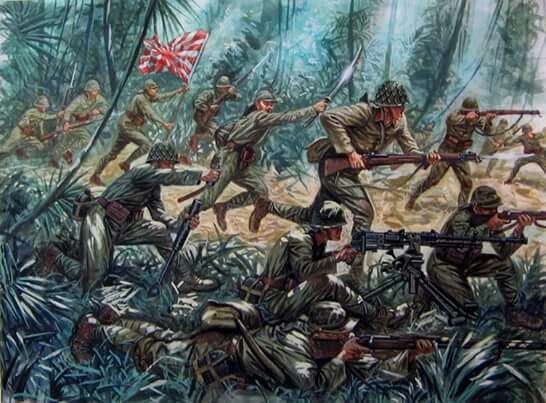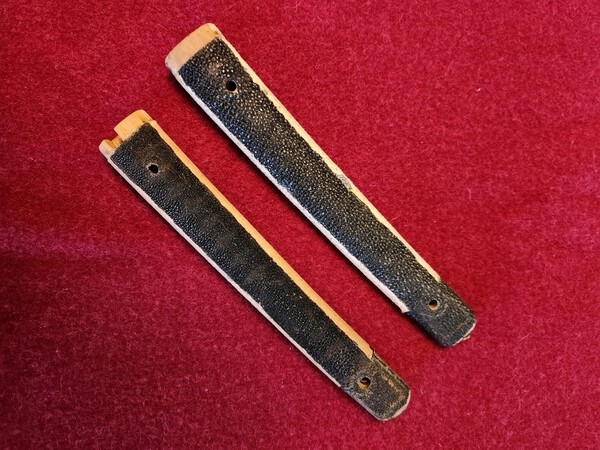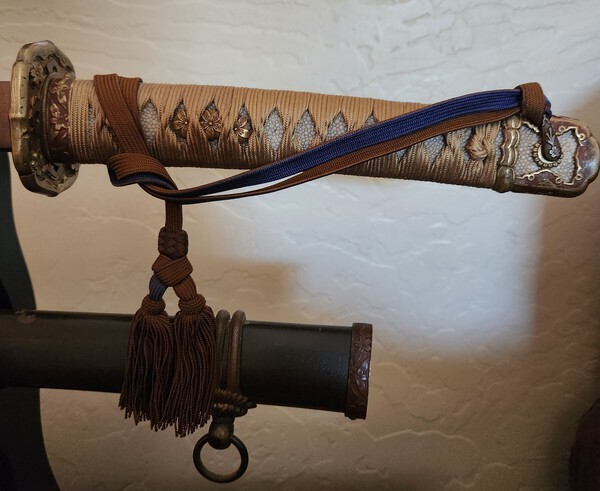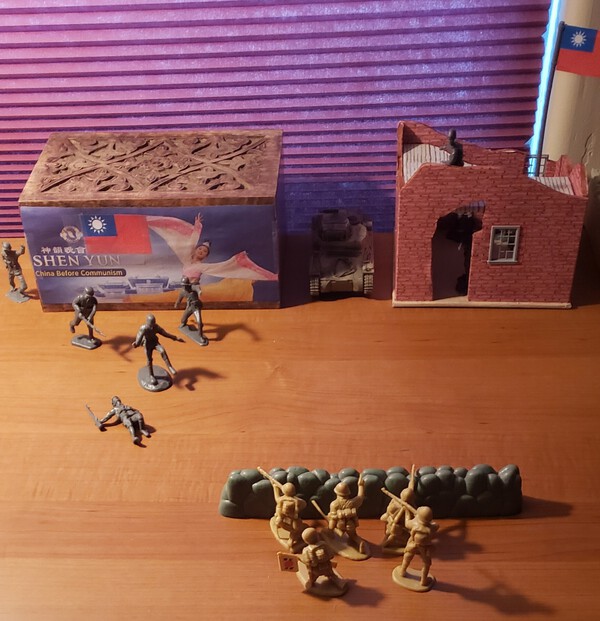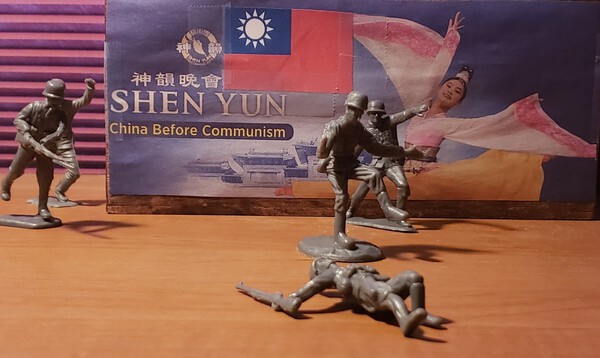-
Posts
341 -
Joined
-
Last visited
-
Days Won
1
Content Type
Profiles
Forums
Events
Store
Downloads
Gallery
Everything posted by Kolekt-To
-
These two Type 97 (Navy) tsukas are without their wraps and fittings - they feature their ray skins, only. These could be useful for restoration projects. Asking $120.00 for the pair. I will cover the cost of shipping. Payment can be made via my PayPal account.
-
Agreed John! For this one, I wanted to take some creative license with the tsuka-maki color and go with the lighter, less common, golden brown. So, the color choice was intentional and I like the way it turned out, in part because it provides an extra splash of color for a display. And, for the record, the saya is not original to the sword (and it's a press fit - there is no chuso), although the blade fits nicely. For another sword, at another time, I probably would have chosen the more common darker brown wrap. This was not a high-end gunto, and some of the koshirae may not even be original to the sword (the saya for sure is not), so I figured if I was going to choose a less conventional color for the wrap, this sword would be a good choice. Best, Geoff
-
Hey guys, It's been awhile since I've posted anything on the forum and I thought that providing an update about my recent experience with a David McDonald tsuka restoration could be of value. Here's the facts: 1. I am very satisfied with the quality of the work that David performed in restoring the tsuka for the sword I refer to as "The Kanetaka" - nice job! 2. David's prices are very reasonable - cost me a total of $375.00 USD, and that included a rebuild of the tsuka (included the new wrap and the addition of new sharkskin), plus the addition of a shitodome, and cost of shipping. 3. David should improve his communication with customers to better manage expectations, including providing consistent status updates. We discussed the job (the tsuka re-wrap), and he agreed to do the work, in March 2022 (last year), if I remember correctly. I sent the sword to him in April 2022 and he acknowledged receiving the sword. David had completed a tsuka re-wrap for me in 2021, and I had confidence in the quality of his work, as documented in the forum by other NMB members. That job took about 3 months from time I sent the sword to him until it was returned to me with the re-wrapped tsuka. He had communicated with me over those three months and provided at least one status update, if I remember correctly. Things went smooth with that job and the communication was satisfactory. From my understanding, although I have no direct experience with this, it can take up to a year or more to have a sword returned if you ship it off for blade polishing, or if you send it to Japan to have it judged and papered. I have not heard of it taking a year for a tsuka re-wrap. David returned my repaired sword a year after receiving it from me - I received it a couple of weeks ago in April. My issue is not with the time it took for the tsuka restoration, although some might say that a year to complete a tsuka restoration/repair is excessive, it is with the lack of consistent communication. I had assumed, perhaps wrongly, that the job would take 3-6 months - this was based on my previous experience with David. Also, I had expected to receive communication (email is David's preferred communication method, although I called and spoke with him briefly on at least two occasions over the past year) on a regular basis (at least once every 1-2 months) in the form of email updates to inform me as to the progress of the work. Suffice to say that communication was not consistent, and it was sometimes months before I would get a response. I think David was dealing with some things over the past year that contributed to his lack of communication. Still, I wish that communication had been more consistent. I really would have been fine with him keeping my sword for a year, or even longer, if he had just kept me updated regularly. The experience caused me anxiety because I was left wondering about what was happening with my sword - at times, I even wondered if I would see my sword again. Anyway, I'm very happy with the quality of David's work. I think there is room for improvement when it comes to communication with customers (and I know I am not the only one who has experienced the lack of consistent communication). When there is a lack of communication it can make the customer feel uncomfortable as they are left wondering. So, going forward, my wish is for David to do as good a job with his customer communication as he does with his repair and restoration work. Perhaps he is already on a new track to improve this aspect of the customer experience - that is my hope. I have attached a photo of the tsuka he restored - nice work David! I am very happy to have The Kanetaka back home and looking better than ever. Best wishes to my fellow collectors, Geoff P.S. Please do not interpret my post as an attack on David as that is not my intention. My intention is to simply describe my recent experience and to help David's potential customers manage their expectations around communication. The quality of David's work is not in dispute.
-
Just have the tsuka re-wrapped with the appropriate Navy menuki replacing the inappropriate Army menuki. Problem solved!
-
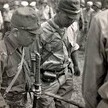
WW2 made Wakizashi - How common are they?
Kolekt-To replied to robinalexander's topic in Military Swords of Japan
I seem to recall this topic being addressed on the board, but were there not cases of army and navy officers carrying waks? I'm not simply referring the cases (or the myth) of pilots or tankers carrying a shorter gunto. I realize that carrying a wak was not common, but it did occur, among the ranks of army and navy officers, did it not? -

Toy soldier IJA officers with Gunto - just for fun!
Kolekt-To replied to Kolekt-To's topic in Military Swords of Japan
Hey Stephen, getting back to the Japanese figures with the Guntos in the first photo, the first figure (on the Left) is holding a sword with a thick, beefy blade compared to the others - do you think it could pass for a Mantetsu? Lol -

Toy soldier IJA officers with Gunto - just for fun!
Kolekt-To replied to Kolekt-To's topic in Military Swords of Japan
Thanks for the comments guys! Trystan, that's good information and those photos are excellent. And, Chris, yes, those figures are not the best, but I had to make due with what I had. The one you mentioned, does look strange - getting hit by gunfire and, presumably, has dropped his rifle. The helmet, rising up, looks a bit like a German paratrooper helmet. Anyway, I included the scene for fun. My focus was on the Japanese officer figures with the swords. -
Gunto-carrying Imperial Japanese Army officers have been represented in toy soldier and military modeling markets for decades. In the photo here I have pulled 4 examples from my 1/32 scale collection for comparison. From left to right are figures from the following manufacturers: Mars, Airfix, BMC, and TSSD. I think it's a toss up between the Mars and Airfix figures for the most accurate regarding Gunto. Both figures have good level of detail. I lean more toward the Airfix figure as having the best representation of a Gunto - for one thing, the sori (curvature) of the blade looks decent. Of course, I can't see hamon in any of the figures' Gunto. Lol The BMC figure lacks detail, but appears to be holding a sheathed sword. The TSSD figure appears to be holding a machete, not a Gunto - perhaps that's the manufacturer's attempt at a Gunto? But a machete-wielding Japanese soldier would not be out of consideration since there are many documented cases of Japanese soldiers using a variety of edged weapons in combat, including bamboo spears and pitchforks (there is a documented report of a U.S. marine on Saipan being killed by pitchfork during the infamous Banzai charge of July 7, 1944). However, if this figure is supposed to be of a Japanese soldier, then it should have a Gunto, not a machete. What figure do you think has the most accurately represented Gunto? P.S. In addition to the Japanese figure comparison photo, I have included a few photos of a quick-made 1/32 scale vignette depicting IJA infantry in action against KMT (Nationalist Chinese) forces during the Battle for Nanking in 1937 - the BMC Japanese officer figure is included here. Note: there is a lack of 1/32 scale Chinese soldier figures (for the period - 1930's-1940's) on the market, so I used selected German Infantry figures as a substitute (only ones with Mauser 98K rifles and stick grenades, as KMT soldiers would have had). The Germans sold China arms and uniforms to supply their army during the 1930's, so, at least superficially (the helmets, uniforms, rifles, etc.), many KMT troops looked somewhat like German troops of the time (have you seen the movie "The Eight Hundred"?). And, yes, that's a German Panzer II in the background (in 1/35 scale - smaller than I'd like, but passable) as China bought 20 of these from Germany in 1937 and 15 of them participated in the Battle of Nanking in November 1937.
-
Yes, John. I was so focused on the immediate red flags that I forgot to take note of the saya's double haikan which would be indicative of a Type 94. At any rate, this thing is a big nothing burger!
-
The immediate red flags for me were the Tsuka wrap, the blade's shape, and the Habaki. Upon closer inspection, I noticed more flaws as Will and Chris have noted. The seller needs to get educated and adjust his price accordingly - or salvage the authentic parts and sell those individually.
-
Just saw this listed on eBay - here's the link: https://www.ebay.com/itm/125183574489?hash=item1d2585c1d9:g:iUcAAOSwO9xiI07z This doesn't look right and the seller is asking $2000.00. I immediately recognized several red flags. What do you guys think? What do you see wrong here?
-
And May 1st 1945 was the beginning of Operation Oboe where the Australians landed at Tarakan and began the Borneo campaign - the last major operation of the war in the Southwest Pacific. One of the photos of the campaign that I saw today featured an Australian Infantry officer showing off a Kai Gunto battle souvenir to a group of his men.
-
How can I learn more about Nihonto Detecting?
-
Thanks Bruce! I'm now thinking that a black lacquer finish for Type 97 sayas would be more common under a leather combat cover vs plain wood.
-
Thanks for your post Tony! Do we know if plain wood sayas were the most common to be fitted with combat covers, or was the black lacquer finish type most common?
-
For those sayas with leather combat covers for the Type 97, is the actual saya usually a plain wood, or is black lacquer finish more common? And, except for the double Ashi earlier version, how would a single Ashi leather-covered Navy saya differ from that of leather-covered Army saya? Would a black lacquer finish determine the difference? Would there be any discernible difference?
-
Question about the leather combat covers for Kai Gunto: Is the single Haiken/Ashi version more common or less common than the double Haiken/Ashi type? Again, I'm just referring to leather combat covers for the Type 97.
-
Thanks John! I'll look for that. I imagine there's also a few gunto in some of the scenes.
-
Are there any movies (perhaps an Indian film?) that feature the British Indian Army fighting in Burma (or India - Imphal, Kohima) during WW2, and that feature actual Indian actors in authentic uniforms?
-
Some questions about this Saya (pictured on eBay - Kai Gunto for sale). Obviously the saya is in bad shape. It appears that it was repaired or wrapped with a cream-colored string. Was this done during the war? If so, was this a common type of repair? Could it be an amateur repair done post-war? Is this saya legit? What do you guys think?
-
Some fine-looking Kai Guntos featured on this thread!
-
I have a Tenshozan forge example in my collection - it did not pass the magnet test (the blade is not made from anti-rust/stainless steel).
-
Christine, The Battle of Manila was incredibly tragic and horrific! Manila is considered the second most devastated Allied city of World War 2. So many Filipino civilians lost their lives. James Scott's book "Rampage" details the battle and the atrocities committed there: https://www.goodreads.com/en/book/show/43726532-rampage Thank you for sharing a little about your Father-in-Law and his experience from that battle. And, from a collector's perspective, there must have been some Type 97 (Kai Gunto) U.S. Army veteran bring-backs from that battle, since most of the Japanese troops involved were navy.
-
What direction are you headed with your collection? All types of gunto? Just Type 95's? What's your vector Victor?

